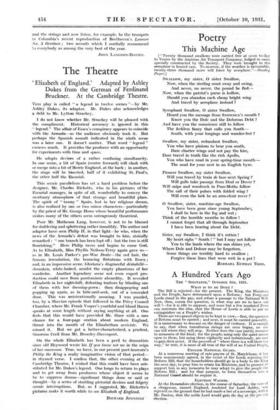The Theatre
s Elizabeth of England.' Adapted by Ashley Dukes from the German of Ferdinand Bruckner. At the Cambridge Theatre.
Tuis play is called " a legend in twelve scenes "—by Mr. Ashley Dukes, its adaptor. Mr. Dukes also acknowledges a debt to Mr. Lytton Strachey.
I do not know whether Mr. Strachey will be pleased with the compliment. Historical accuracy is ignored in this " legend." The affair of Essex's conspiracy appears to coincide with the Armada—as the audience obviously -took it. But perhaps the Spanish assault indicated in the ninth scene was a later one. It doesn't matter. That word legend " excuses much. It provides the producer with an opportunity for experiments with time and space.
He adopts devices of a rather confusing simultaneity. In one scene, a bit of Spain (centre forward) will clash with or merge into a bit of Merrie England, at the back ; in another, the stage will be bisected, half of it exhibiting St. Paul's, the other half the Escurial.
This scenic parallelism has set a hard problem before the designer, Mr. Charles Ricketts, who in his pictures of the Escurial manages, in spite of all, wonderfully to convey the mortuary atmosphere of that strange and beautiful place. The spirit of " tawny " Spain, lost in her religious dream, is also realized by one or two minor characters—particularly by the priest of Mr. George Howe whose beautiful performance makes many of the others seem outrageously theatrical.
Poor Mr. Matheson Lang, however, is not to be blamed for doddering and spluttering rather inaudibly. The author and adaptor have seen Philip II. in that light—he who, when the news of the Armada's defeat was brought to him, stoically remarked : " one branch has been lopt off ; but the tree is still flourishing." Here- Philip raves and begins to curse God. As to Elizabeth, Miss Phyllis Neilson-Terry again gave us— as in Mr. Louis Parker's pre-War Drake—the red hair, the famous irresolution, the bouncing flirtations with Essex ; and, in an impressive scene, Gloriana's disgraceful deshabille— shrunken, white-haired, amidst the empty phantoms of her wardrobe. Another legendary scene not even expert pro- duction could save from pantomimic absurdity. It revealed Elizabeth in her nightshift, defeating traitors by blinding one of them with her dressing-gown ; then disappearing and popping up again, as in hide-and-seek, out of a concealed door. This was unintentionally amusing. I was puzzled, too, by a Shavian episode that followed in the Privy Council Chamber, where Mr. Frank Vosper's youthful and bland Bacon speaks at some length without saying anything at all. One feels that this would have provided Mr. Shaw with a rare chance for a four-page oration about modern England, thrust into the mouth of the Elizabethan arriviste. We missed it. But we got a better-characterized, a prudent, timorous Cecil from Mr. Bromley-Davenport.
On the whole Elizabeth has been a peril to dramatists since old Heywood wrote his If you know not me in the reign of her successor. True, we have, in our present poet-laureate's Philip the King a really imaginative vision of that period— in rhymed verse. I confess that, the other evening at the Cambridge Theatre, I wished that this could have been sub- stituted for Mr. Dukes's legend. One longs to return to plays and to get away from producers whose object it seems to be to suppress drama—significant things done or said or thought—by a series of startling pictorial devices and fidgety scenic interruptions. But, as I suggested, Mr. Ricketts's pictures make it worth while to see Elizabeth of England.
RICHARD JENNINGS


















































 Previous page
Previous page